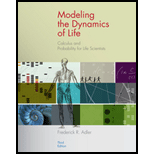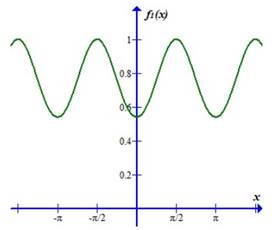
Concept explainers
(a)
To find: The derivatives of the given function, the critical points, and the point of infection. Also, determine the situation when more and more cosines are piled up and explain it in terms of the updating function
(a)
Answer to Problem 43E
The derivate is
Explanation of Solution
Given:
The expression is
Calculation:
The critical point is the point on the curve where the slope of the tangent is zero and the tangent is parallel to the x axis.
The point of inflexion is the point on the curve at which the sign of the curvature changes.
Consider the given expression is,
Differentiate the above equation with respect to
The graph for the above function is shown in Figure 1

Figure 1
Then, the critical points are
The point of inflexion is
The critical points are
From the above calculations it is observed that as more and more cosines are piled up the graph of the function is flat and stable at one value.
(b)
To find: The derivatives of the given function, the critical points, and the point of infection. Also, determine the situation when more and more cosines are piled up and explain it in terms of the updating function
(b)
Answer to Problem 43E
The derivate is
Explanation of Solution
Given:
The expression is
Calculation:
The critical point is the point on the curve where the slope of the tangent is zero and the tangent is parallel to the x axis.
The point of inflexion is the point on the curve at which the sign of the curvature changes.
Consider the given expression is,
Differentiate the above equation with respect to
The graph for the above function is shown in Figure 1

Figure 1
Then, the critical points are
The point of inflexion is
The critical points are
From the above calculations it is observed that as more and more cosines are piled up the graph of the function is flat and stable at one value.
(c)
To find: The derivatives of the given function, the critical points, and the point of infection. Also, determine the situation when more and more cosines are piled up and explain it in terms of the updating function
(c)
Answer to Problem 43E
The derivate is
Explanation of Solution
Given:
The expression is
Calculation:
The critical point is the point on the curve where the slope of the tangent is zero and the tangent is parallel to the x axis.
The point of inflexion is the point on the curve at which the sign of the curvature changes.
Consider the given expression is,
Differentiate the above equation with respect to
The graph for the above function is shown in Figure 1

Figure 1
Then, the critical points are
The point of inflexion is
The critical points are
From the above calculations it is observed that as more and more cosines are piled up the graph of the function is flat and stable at one value.
(d)
To find: The derivatives of the given function, the critical points, and the point of infection. Also, determine the situation when more and more cosines are piled up and explain it in terms of the updating function
(d)
Answer to Problem 43E
The derivate is
Explanation of Solution
Given:
The expression is
Calculation:
The critical point is the point on the curve where the slope of the tangent is zero and the tangent is parallel to the x axis.
The point of inflexion is the point on the curve at which the sign of the curvature changes.
Consider the given expression is,
Differentiate the above equation with respect to
The graph for the above function is shown in Figure 1

Figure 1
Then, the critical points are
The point of inflexion is
The critical points are
From the above calculations it is observed that as more and more cosines are piled up the graph of the function is flat and stable at one value.
Want to see more full solutions like this?
Chapter 2 Solutions
Modeling the Dynamics of Life: Calculus and Probability for Life Scientists
- Algebra & Trigonometry with Analytic GeometryAlgebraISBN:9781133382119Author:SwokowskiPublisher:Cengage
